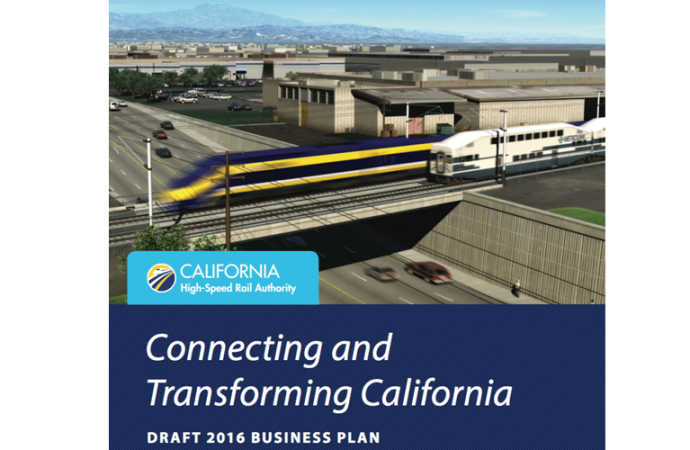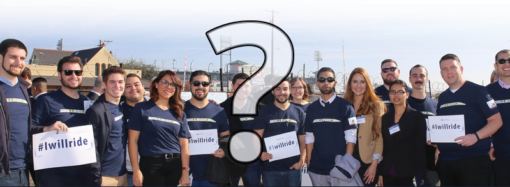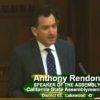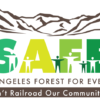Review of California’s High-Speed Rail Authority’s 2016 Business Plan- Part 1
CHSRA 2016 Draft Business Plan: a/o Feb. 18, 2016
The Rail Authority released its 2016 business plan and – no surprise – they have done another about-face and will head north instead of south. They’ve replaced their Merced to San Fernando Valley plans with one that goes from San Jose to a field on the northern-most edge of Shafter. (Check this video – a real-life case of fact being stranger than fiction. YouTube) The switch to north shrinks the project from 300 to 250 miles. In round numbers the Authority says this reduced route will cost $20 billion instead of the publicly debated range of $31 to $40 billion for the southern route. Half of that $20 billion is dependent on collecting $10 billion in cap-and-trade funds, a risky assumption.
The Authority claims the overall cost was reduced from $67.6 billion to $64.2 billion primarily based on lessons learned, value engineering, and lower construction bids – mind you not proven expenditures, just estimates – for various segments. They also confess they are going to be late, the first segment will be ready for service in 2025, and the whole Los Angeles to San Francisco segment will not be ready until 2029, exactly 9 years from the original date promised.
The change to head north has been suspected since the August 2015 board meeting when Northern HSR Director Ben Tripousis was told in no uncertain terms he must get the two northern segments environmentally cleared by December 2017. He was told there could be no slippage in the time line. This was a real mystery at the time since those segments were not supposed to be operational until the end of 2028/2029. The board didn’t discuss why, they just said it had to be done.
Dan Richard told Assemblyman Jim Patterson (R- Fresno) in the January 27, 2016 Assembly Finance Meeting that the staff was working with the board on the business plan. In that meeting, Richard said the cost would be less, the time frame longer but as far as the location, they were relooking at all options but most of all they were most interested in getting trains up and running as fast as possible and as cheaply as possible. Video of Jan. 27, 2016 Assembly Finance Meeting
See the LA Times coverage of this important meeting. The public was limited to a meager 1 minute of comment each in this completely inadequate legislative meeting.
We all know the switch was about cost, feasibility and the time they needed to get through the Tehachapi Mountains, which separate the Central Valley from Southern California. Besides the cost and time of miles of tunnels, there are tremendous power grid problems that challenge the southern route through the Tehachapi Mountains. Rail planner Richard Tolmach made a public comment at a Sacramento legislative hearing years ago where he said it could take a decade to establish adequate electrical service to get over those mountains. So with the Authority facing all these problems, it’s easy to see that instead of “moving forward” (the Authority’s favorite sound bite), they’re turning 180 degrees to head north, away from their problem mountains.
We will look at some of the obvious things in the newest draft plan. It’s still about lack of funding, questions about cost to build, ability to stay within Prop 1A’s travel time requirements and lack of ridership.
The money: How they plan on paying for it
One must look at both cost and capital. Do they have the money to fund the actual cost of construction? The rail authority expects to pay for $20.6 billion initial Operating Segment headed north with some “iffy” propositions:
- Authority says it has $3.1 billion in Federal grants
Problem: Today they don’t have all $3.165 billion, which was the total of the American Recovery and Reconstruction Act (ARRA) grants from the FRA, plus the FRA grant of $928 million of 2010 funds. Today, the total of the grants must be adjusted down and the remaining balance estimated based on their spending over the past several years.
Based on an Federal Railroad Administration report about the High-Speed Rail project, published at the end of January, they have up to approximately $2.6 billion remaining of the total grant funds. On page 19 of this report it shows they have spent $855 million of FRA funds. They had a total of $3.48 billion, which leaves around $2.6 billion unspent at the end of January.
Note on page 20 of this report they haven’t updated their state fund spending since last August. The same $371 million, which includes Prop 1A funds for planning and environmental spending and Cap-and-Trade fund spending was in a previous November FRA report.
- Authority believes it “has” $2.609 billion in Proposition 1A bond proceeds
Problem: Although this money has been appropriated, it can’t be spent. The Rail Authority admits on page 3 of their September 2015 Semi-Annual Operations Report that they can’t get the bond funds because lawsuits are preventing access. This is true. The lawsuit they refer to includes a ruling that held up to appeal which instructs the Authority to prepare a second funding plan and complete all environmental work prior to accessing the funds, per the requirements of Prop 1A. So blaming the lawsuits is only a half-truth since they are not taking responsibility for the remedy, which is entirely in their control.
- The Authority plans on going after $2.9 billion in additional federal funds so they can extend the line south to Bakersfield and north to (only) 4th and King in San Francisco. However, Prop 1A specifies the Transbay Transit Center. It would cost an additional $3-4 billion to extend it there.
Problem: Unless they accumulate some small federal grants that the Federal Railroad Administration is in charge of doling out, it is highly unlikely Congress will allocate more funds to the high-speed rail program. Congressman Jeff Denham commented on the new business plan,
“Congress is never going to allocate more money to a project that lacks the ridership numbers, speeds, private funding and voter support once promised. Without the billions in funding they need, the Authority’s change in plans amounts to nothing more than wishful thinking.”
- The Authority will seek an appropriation for $4.166 billion in Proposition 1A bond proceeds to help fund capital costs for this first high-speed rail line
Problem: This is close to all the remaining Prop 1A funds left, all their eggs in this one basket, since they’ve spent a bunch on planning and environmental work. If they don’t get new federal funds or private investment funds, they plan on matching state cap-and-trade funds to state bond funds to permit the release of the bond funds, which must be matched. Those cap-and-trade funds will not stretch that far.
The Authority says it will use Cap and Trade proceeds received through 2024 to help fund the capital costs for the Silicon Valley to Central Valley line. We estimate this amount to be $5.341 billion including amounts spent to date.
Problem: AB 32 currently ends in 2020. There are two lawsuits challenging the use of this money. See a broader section on Cap-and-Trade later in the article.
Cost:
Now let’s talk about cost. This new business plan says the project cost was reduced again to $64.2 billion for the entire Phase 1 from Los Angeles Union Station to the Transbay Terminal and even though they still have to tackle the Tehachapi Mountain segment with all those tunnels and power grid challenges. Later by no means, means cheaper.
At the February board meeting, the HSR staff even asked for a contingency fund increase for CP- 1, the location of the first construction segment, one they say they may never need. See the one-minute YouTube. This slick move is in lieu of actually increasing project projections. This begs the question if you may not need it, why are you asking for it?
Plus the clock is ticking on their remaining ARRA federal funds say between 1 billion and 1 ½ billion. Unless the ARRA funds are spent by September 30, 2017, they no longer have the right to use them. Without those, they can’t match with bond funds, which itself is a moot point since they can’t get the bond funds due to lack of compliance with Prop 1A. They are having issues spending the funds because they can’t acquire the proper amount of land to make headway.
If one can’t get the bond funds, one could suggest why not match the federal funds with cap-and-trade dollars. That’s what they are doing now but frankly there isn’t enough cap-and-trade dollars to go around. And by the way, no one ever envisioned using these state funds to match other state funds.
Federal funds and public records issues:
Bill Warren, finance expert concerning the HSR program, says it’s really difficult to figure out what the most accurate view is of the federal funds because the Authority constantly delays the release of reports that it sends to the Federal Railroad Administration. Right now the year-end report still hasn’t been released though we are approaching March. Warren laments, “It is a disgrace that the Authority can be so late in publicly posting reports like the quarterly Funding Contribution Plan (FCP) reports and no one gets fired”.
Warren believes “the ARRA grants were for $2,550M so they had about $1,540M left on Jan 1 2016; plus the $928M of FY10 funds (which they have not touched) so total FRA funds still left are about $2,470M maybe a bit less.”
Delay and Hide tactics:
Just last week the Authority refused to release the year-end report they are required to send to the FRA citing the need for a two-week extension with no explanation since they have the report. Document delivery is promised by March 18, 2016. The report was for activity ending in December 31, 2015.
The Authority also commonly label their documents with a draft stamp which was a predominate practice in the building of the Bay Bridge. In a January 24, 2014 legislative hearing called “Lessons Learned,” it was disclosed that engineers were told whenever possible not to put anything in writing, not paper or email, communicate orally to avoid issues from being discovered through the public records act. If they did put something in writing, they labeled many draft. In some cases those attempting to get information didn’t get documents for as much as 7 months. The High-Speed Rail Authority, following in their footsteps, headed by CEO Jeff Morales and by the way ex-manager of the Bay Bridge, purposely delays the public getting documents. They have gone through the extreme measure of changing formats in monthly progress reports to hide issues. In a tweet from the Californians Advocating Responsible Rail Design (CARRD) they show the deliberate attempt to remove key information categories from these important reports in order “to avoid confusion in public records request. ” The Authority told their consultants to remove the categories of Major/Key Issues & Areas of Concern/Risk Management. This request, directly contradicted auditor requests for more information. This from the self-proclaimed, “most transparent agency in the world.” One would think the companies involved, even the federal government, would like a written track record of the issues for a project of this magnitude.
The draft loophole used to delay responses to public records requests, not intended by the existing law, must be fixed by California’s Legislature. The obvious attempt to hide information should also be handled by law, which includes fines and imprisonment for those who engage in the practice of deliberately hiding key information from the public.
The Cap-and-Trade funds – otherwise known as the “everything to everybody” funds:
So far the Authority has promised to use cap-and-trade funds to fund investments in Southern California, to help construct the new initial operating segment heading north in order to match federal grant spending, to fund the rest of the Phase One project (Los Angeles Union Station to Transbay Terminal in San Francisco) and even to possibly fund Caltrain for its electrification project. It seems Caltrain is beginning to get nervous that the Rail Authority will be delayed in delivering the promised $600 million coming from Prop 1A funds.
That’s a tall order expected to stretch an estimated $500 million a year in expected cap-and trade revenue.
First the Authority has the responsibility to use the cap-and-trade funds as the matching vehicle for the Federal ARRA funds, period. For every dollar they spent of the federal funds, they must spend that exact amount in state funds. They also have $928 million called the 2010 funds and they are to be matched at a 30% rate. Right now cap-and-trade is the only investment vehicle to match Federal grant funds spending.
It would seem that since the Authority has this matching requirement first, it will be years before they can use the cap-and-trade funds for anything more unless they are able to sell that stream of income and get a chunk of capital for it in advance and making payments with the cap-and-trade revenue. But before this can be contemplated the Authority has to lobby successfully to extend the cap-and-trade program, which currently ends in 2020. In the new business plan they anticipate cap-and-trade revenue until 2060.
The Legislative Analyst’s Office thinks that the legislature should extend AB 32 by a 2/3 vote. See their handout written February 18, 2017. This would seemingly knock out a lawsuit sitting in appellate court that asserts that the cap-and-trade revenues are really taxes, not fees, and therefore a 2/3 vote would be required to legitimize them.
Here the Barclays proposal that was sent to the Authority when they were recently in search for private funds, a search that reaped zero takers. Barclays Bank from the UK suggested that with a few modifications from the state Legislature, the Authority might raise as much as $10 billion dollars. But in order to be successful at doing that, there are lots of “ifs” including the extension of AB 32.
They suggest that four things must first happen:
- The state must prevail pending legal challenges.
- The state must create laws that allow for supporting borrowing against cap-and-trade revenues.
- AB 32 must be extended beyond 2020.
- The Legislature must protect the 25% appropriation of Greenhouse Gas Reduction Fund (GGRF)evenue from being changed in the future as long as the “loan” is outstanding.
The Lawsuits:
The Authority awaits a decision from the second part of the Tos/Fukuda/Kings County suit heard by Sacramento Superior Court Judge Michael Kenny. Legal briefs and explanation of the suit can be found here. This taxpayer fraud lawsuit alleges that the rail authority is in violation of the voter initiative Prop 1A because the Authority can’t make the travel times required, the blended plan is not part of Prop 1A and therefore illegal, and the project is not financially viable.
See this article on exactly how the plaintiffs’ day in court went after waiting four years to be heard. The court is expected to rule within the next 75 days. Regardless of the outcome, critical issues are at stake, See Dan Walters’ piece on why it’s important that the state honor promises made in bond measures to the voters of California.
Additional lawsuits: Lawsuit happenings from the Transportation Solutions Defense and Education Fund (TRANSDEF) website: http://transdef.org/HSR/HSR.html are all listed on this site.
Below are five suits some directly associated with cap-and-trade monies outlined by the Barclay’s proposal that must be defeated.
- Fresno-Bakersfield–Two counties, a city, two non-profits and a partnership challenge the project-level FEIR for this section of the HSR project (This case is currently on hold, awaiting California Supreme Court resolution of a conflict between two appellate decisions on the federal preemption of CEQA.)
- Appeal of STB’s Order declaring that CEQA is entirely preempted for the HSR project.
- Caltrain Electrification EIR Challenge–TRANSDEF, Atherton and CC-HSR challenge the EIR’s failure to analyze the impacts of HSR on the Caltrain Corridor.
- Morning Star Packing: This litigation, per the Barclays Bank proposal, is against CARB, which consolidates 2013 challenges to the cap-and-trade program from the California Chamber of Commerce and the National Association of Manufacturers, is currently in the briefing process before the State of California Third Appellate District Court of Appeal. The plaintiffs argue that auction revenues in the Greenhouse Gas Reduction Fund amount to a tax under Proposition 13, that auctions and reserve sales of allowances are not authorized by AB 32, and that statutes enacted after 2012 that provide for disposition of auction proceeds are invalid. See an article written about this suit: “Business Group Takes CARB Over Cap-and-Trade”
- The Transportation Solutions Defense and Education Fund (TRANSDEF), per the Barclays Bank proposal, has been challenging the high-speed rail project in the courts since 2008, first with its opposition to the Pacheco Pass route. TRANSDEF is now litigating an action filed in 2014 with the Superior Court for the County of Fresno against CARB and CHSRA asking the court to invalidate and declare improper and illegal “any and all actions taken by the California Legislature to fund the HSR Project with funds in the Greenhouse Gas Reduction Fund, and specifically any legislative appropriation for the HSR project made in reliance upon the inclusion of the HSR project in the [First Update to CARB’s Climate Change Scoping Plan].” See the one page list of why TRANSDEF filed the suit.
If one of these last two suits wins regarding cap-and-trade it could be game over for the Authority’s only on-going funding mechanism.
Will they be able to get the continued cap-and-trade money? Not likely, according to Stuart Flashman, the Attorney in the Tos/Fukuda/Kings County case.
According to an article from the San Jose Mercury News, Flashman, Oakland environmental attorney says, “There’s a greater chance of golden eagles dropping billions of dollars out of the sky than there is of this project getting cap-and-trade money after 2020 without action by the Legislature.” Flashman represents several groups suing the authority in an attempt to halt the project. “They can fantasize all they want, but we’ll see them in court.”





